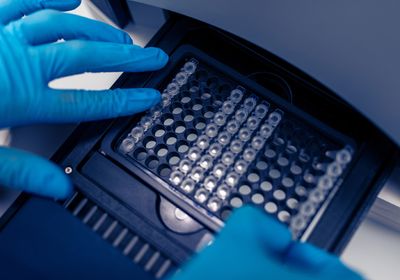ABOVE: The inactive X chromosome may promote autoantibodies that attack the body’s own cells. ©iStock, bymuratdeniz
Autoimmune conditions in which the immune system mistakenly attacks the body’s cells are four times more common in the female sex, but scientists don’t know why. Silent sex chromosomes could hold the answer, according to a preprint posted on bioRxiv that has yet to undergo peer review.1
“It’s quite extensive, detailed, and incredibly well done,” said Robert Lahita, a rheumatologist at St Joseph’s Health Medical Center who was not involved with the work but who has collaborated with one of the coauthors in the past.
For the past 40 or 50 years, researchers searched for the trigger behind sex-biased autoimmunity. “We have thought that the X chromosome had something to do with the autoimmune predominance. This paper seems to direct us towards the X chromosome, particularly those that are inactivated,” Lahita added.
In humans, female cells possess two X chromosomes, one of which is inactive, whereas male cells possess one active X chromosome and one active Y chromosome.2 A clue to explaining female-biased autoimmunity comes from people with Klinefelter syndrome who have the male set of sex chromosomes (XY) plus an extra inactive X chromosome. These individuals have a likelihood similar to women for developing autoimmune conditions like lupus, suggesting that the extra inactive X chromosome may be to blame for the increased risk.3
Howard Chang, a dermatologist at Stanford University and author of the preprint, studies how the second X chromosome in females becomes inactivated. His team turned to a long noncoding RNA called the X-inactive specific transcript (XIST), which orchestrates the shutdown of the inactive X chromosome.4 In 2015, his team identified a set of 81 proteins that bind to XIST, forming a large RNA-protein complex.5
Around the same time, Chang was reviewing for a test to renew his specialty certification as a dermatologist. “Part of the test involves memorizing the autoantibody tests that you use to diagnose patients with certain diseases,” he said. He noticed that some of the autoantibodies used for these tests detect human proteins that his team found bind to XIST. This led him to hypothesize that the XIST RNA-protein complex might underlie the autoimmunity female bias since XIST isn’t expressed in males.
To test his theory, Chang and his team genetically modified male mice to express Xist to see if it would boost their autoimmunity risk. Introducing the full-length version of Xist into the only X chromosome is lethal, so they used a modified form that lacked the region that drives inactivation. Following treatment with pristane, a chemical that induces lupus, male mice with Xist had higher levels of autoantibodies than male mice without Xist expression, and their levels were closer to those found in female mice. These findings suggested that Xist expression could contribute to autoimmunity.
Xist expression in male mice receiving pristane also led to damage in multiple organs affected in lupus, including the kidneys, liver, lungs, and spleen. However, the extent of damage was not as bad as in female mice receiving pristane, suggesting that other factors exacerbate lupus in female mice. For example, because X chromosome inactivation is not completely effective, some genes that escape silencing may still express at low levels, and their protein products may interact with Xist.
“They’re not mutually exclusive, and if anything, they’re likely to work together,” Chang said. In women, the TLR7 gene on the inactive X chromosome escapes inactivation, boosting levels of an immune receptor that detects RNA-protein complexes.6,7 In future studies, the team hopes to determine whether the XIST RNA-protein complex triggers the female immune system through TLR7.
See also “Genes that Escape Silencing on the Second X Chromosome May Drive Disease”
Beyond autoantibodies, Xist expression in male mice also altered adaptive immune cells. Among these changes, the levels of proteins such as Siglec-G and complement receptor 2, both of which regulate autoantibody-producing B cells and suppress autoimmunity, dropped in male mice with Xist.8,9 Chang and his team observed a similar suppression in several proteins that tame T cell reactivity. The researchers have not fully uncovered the consequences of these changes, but suppressing proteins that preempt autoimmunity may create B and T cells that are more trigger-happy toward the body’s own proteins.
With their mouse data in hand, the team turned to humans. They collected blood from healthy people and people with three different autoimmune conditions: dermatomyositis, scleroderma, and lupus. They found higher levels of autoantibodies against 40 XIST-associated proteins in people with these conditions, revealing that the XIST RNA-protein complex may also trigger autoimmunity in humans.
For 28 of these XIST-associated proteins, researchers have not previously detected and described autoantibodies. These autoantibodies could potentially serve as novel markers of autoimmune conditions and could hold promise for improved detection. Currently, clinicians struggle to diagnose autoimmune disorders, in part because distinct conditions often share similar symptoms. Lahita said, “Patients come in with snippets of reactivity, which don’t point to one but maybe several [conditions]. For example, a patient with scleroderma may have localized scleroderma, diffuse scleroderma, or an offshoot called CREST syndrome.” Autoantibody markers that help narrow the diagnosis could better equip doctors to treat their patients, he explained.
References
- Dou DR, et al. Xist ribonucleoproteins promote female sex-biased autoimmunity. bioRxiv. 2023.
- Dossin F & Heard E. The molecular and nuclear dynamics of X-chromosome inactivation. CSH Perspect. 2022;a040196.
- Seminog OO, et al. Associations between Klinefelter’s syndrome and autoimmune diseases: English national record linkage studies. Autoimmunity. 2015;48(2).
- Jacobson EC, et al. A lifelong duty: how Xist maintains the inactive X chromosome. Curr Opin Genetics Dev. 2022;75(101927).
- Chu C, et al. Systematic discovery of Xist RNA binding proteins. Cell. 2015;161(2):404-416.
- Souyris M, et al. TLR7 escapes X chromosome inactivation in immune cells. Sci Immunol. 2018;3(19):eaap8855.
- Hwang S, et al. B cell TLR7 expression drives anti-RNA autoantibody production and exacerbates disease in systemic lupus erythematosus-prone mice. J Immunol. 2012;189(12):5786-5796.
- Müller J, et al. Siglec-G deficiency leads to autoimmunity in aging C57BL/6 mice. J Immunol. 2015;195(1):51-60.
- Erdei A, et al. New aspects in the regulation of human B cell functions by complement receptors CR1, CR2, CR3 and CR4. Immunol Lett. 2021;237:42-57.







